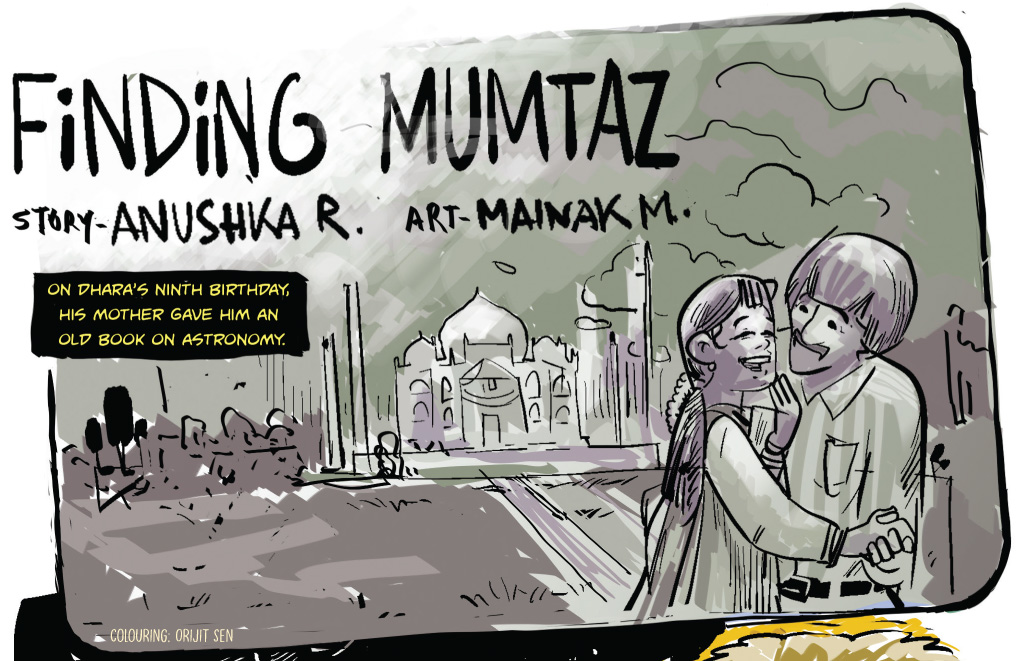
Vol 1 Issue 4 | January-March 2022
Finding Mumtaz
Story by Anushka Ravishankar | Art by Mainak Mitra
Charbagh: the Magic of Four
The Charbagh, the garden that begins at the gate and ends at the base of the mausoleum, is one of the most striking aspects of the Taj Mahal. It is based on the Timurid style of gardens, which were brought in from Persia by Babur, and which are conceptualised on the lines of the gardens of paradise.
According to Islamic beliefs, the garden of paradise has four rivers – one flowing with water, one with milk, one with honey, and one with wine. Paradise is also described as a garden with an abundance of trees, flowers, fruits and birds. The design of the Charbagh, with its symmetry, delicacy and its variety of flora, has its origin in this idea.
Mumtaz Mahal and Shah Jahan: Love Doesn’t Die with Death
Mumtaz Mahal died in 1631, while giving birth to Shah Jahan’s 14th child. Immediately after her death, Shah Jahan began to plan the mausoleum and garden that became the Taj Mahal. According to the court chroniclers of the time, Shah Jahan was inconsolable when Mumtaz died. He went into seclusion and mourned her death for a year.
In later life, when Shah Jahan became old and infirm, his son Aurangzeb violently usurped the throne for himself and imprisoned his father in a room in the Agra Fort, with a window that looked out onto the Taj Mahal. Shah Jahan is believed to have spent the last eight of his life staring at the monument he had built in memory of his wife. After he died on 22 January 1666, his body was placed in a sandalwood coffin and taken to the Taj Mahal, where he was buried beside his beloved Mumtaz Mahal.
Hard Rock at the Taj: Pietra Dura or Parchin Kari
Mughal architecture is a composite of Persian, Turkish, Timurid, Central Asian and Indian architecture. Pietra dura is a decorative technique that originated in Florence at the end of the 16th century. In Italian it means ‘hard stone’. It was brought to the Mughal court by Italian artisans and came to be known in India as parchin kari.
In pietra dura, highly polished coloured stones are inlaid in depressions carved onto marble or sandstone, to make beautiful and complex patterns. The pietra dura on the Taj Mahal is of exceptionally high quality. Read more about this marvellous design technique here.
Saving the Taj Mahal from bombing
During World War 2, the British felt that the Taj Mahal was extremely vulnerable to bombing by the Japanese and the Germans. In an effort to mislead the Luftwaffe bombers, the British placed bamboo scaffolding over the dome of the Taj in 1942. The idea was that, from high above, enemy pilots would think of it only as a big pile of bamboo and as a result, not bomb the monument.
Copycat Taj Mahals
From replicas of the Statue of Liberty and the Eiffel Tower to takes on Venice, it seems pretty clear that when you build a beautiful landmark, there’s sure to be copycats. Unsurprisingly, the same goes for the Taj Mahal. The Bibi ka Maqbara, also known as ‘the mini Taj Mahal’ was commissioned by Aurangzeb in 1660 in Aurangabad, as a mausoleum for his wife Dilras Banu Begum, who died during childbirth, just like her mother-in-law Mumtaz Mahal. Read about the ways in which this ‘mini Taj’ is similar to the original, yet different, here.
Another copycat-Taj which is also, like its inspiration, a tomb built in memory of a beloved spouse, is the Red Taj. It was built for Dutch traveller-turned-army-officer, John Hessing, by his wife after he died.
Lastly, did you know that Donald Trump had a casino he called Trump Taj Mahal, which he once called “the eighth wonder of the world”?

